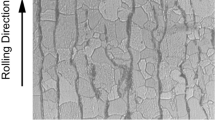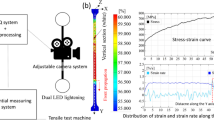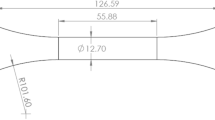Abstract
It is now possible using digital-image correlation techniques to precisely measure deformation within a developing necking instability, during forming-limit experiments. However, the current standards for measuring limit strains rely only on data outside of the instability. We propose exactly the opposite, to use just those deformations from the material where the instability will develop. Marciniak and Kuczynski experiments were performed on a drawing-quality steel and the entire deformation history recorded with a high-resolution photographic camera. The strain fields from these image were analyzed with the digital-image correlation program NCORR, concentrating on where the necking instability would form. The Merklein et al. (CIRP Ann Manuf Technol 59:295-298, 2010) and Hotz et al. (Key Eng Mater 549:397-404, 2013) temporal analyses were modified through an original smoothing technique to uniquely identify, through a correspondence of results, when the deformation acceleration rate begins to rapidly increase within the developing instability. This defines a limit strain. These results were compared to the standard Bragard-type determination specified in the norm International Standard ISO 12004-2:2008 (Metallic materials—sheet and strip: determination of forming-limit curves. Part 2—determination of forming-limit curves in the laboratory, International Organization for Standardization, Geneva, 2008). We found a close agreement in balanced-biaxial tension between our proposed technique and the standard Bragard-type analysis. However, in plane-strain and uniaxial deformation the standard analysis appeared to be excessively conservative, by as much as 40% for our steel.


Reprinted from CIRP Annals—Manufacturing Technology, Vol 59, Ed 1, M. Merklein, A. Kuppert, M. Geiger, Time dependent determination of forming limit diagrams, pp 295-298, Copyright 2010, with permission of Elsevier







Similar content being viewed by others
References
J. Blaber, B. Adair, and A. Antoniou, Ncorr: Open-Source 2D Digital Image Correlation Matlab Software, Exp. Mech., 2015, 55, p 1105–1122
A. Bragard, J.C. Baret, and H. Bonnarens, A Simplified Technique to Determine the FLD at the Onset of Necking, Rapp. Centre Rech. Metall., 1972, 33, p 53–63
M. Gensamer, Strength and Ductility, Trans. Am. Soc. Met., 1946, 36, p 30–60
G.M. Goodwin, Application of Strain Analysis to Sheet Metal Forming Problems in the Press Shop, SAE Technical Paper, No. 680093 (1968), pp. 380–387
GOM, GOM Service Area [Online] (GOM, 2019). Available: http://www.gom.com/metrology-systems/aramis.html. Accessed 20 Dec 2019
A.K. Ghosh and S. Hecker, Failure in Thin Sheets Stretched Over Rigid Punches, Metall. Mater. Trans. A, 1975, 6A, p 1065–1074
A.K. Ghosh, The Influence of Strain Hardening and Strain-Rate Sensitivity on Sheet Metal Forming, Trans. ASME J. Eng. Mater. Technol., 1977, 99(3), p 264–274
W. Hotz, M. Merklein, A. Kuppert, H. Friebe, and M. Klein, Time Dependent FLC Determination: Comparison of Different Algorithms to Detect the Onset of Unstable Necking Before Fracture, Key Eng. Mater., 2013, 549, p 397–404
International Standard ISO 12004-2:2008, Metallic Materials—Sheet and Strip: Determination of Forming-Limit Curves. Part 2—Determination of Forming-Limit Curves in the Laboratory, International Organization for Standardization, Geneva, 2008
R.A. Iquilio, F.M. Castro Cerda, A. Monsalve, C.F. Guzmán, S.J. Yanez, J.C. Pina, F. Vercruysse, R.H. Petrov, and E.I. Saavedra, Novel Experimental Method to Determine the Limit Strain by Means of Thickness Variation, Int. J. Mech. Sci., 2019, 153-154, p 208–218
S.P. Keeler and W.A. Backofen, Plastic Instability and Fracture in Sheets Stretched Over Rigid Punches, Trans. Am. Soc. Met., 1963, 56, p 25–48
M.E. Leonard, F. Ugo, M. Stout, and J.W. Signorelli, A Miniaturized Device for the Measurement of Sheet Metal Formability Using Digital Image Correlation, Rev. Sci. Instrum., 2018, 085114, p 89–95
Z. Marciniak and K. Kuczynski, Limit Strains in the Processes of Stretch-Forming Sheet Metal, Int. J. Mech. Sci., 1967, 9, p 609–620
A.J. Martínez-Donaire, F.J. García-Lomas, and C. Vallellano, New Approaches to Detect the Onset of Localised Necking in Sheets under through-Thickness Strain Gradients, Mater. Des., 2014, 57, p 135–145
M. Merklein, A. Kuppert, and M. Geiger, Time Dependent Determination of Forming Limit Diagrams, CIRP Ann. Manuf. Technol., 2010, 59, p 295–298
J. Min, T.B. Stoughton, J.E. Carsley, and J. Lin, Comparison of DIC Methods of Determining Forming Limit Strains, in International Conference on Sustainable Materials Processing and Manufacturing, SMPM 2017. Procedia Manufacturing, vol. 7 (2017), pp. 668–674
K. Nakazima, T. Kikuma, and K. Hasuka, Study on the Formability of Steel Sheets, Yawata Technical Report, No. 264, (1968), pp. 8517–8530
M.A. Sutton, J.-J. Orteu, and H.W. Schreier, Image Correlation for Shape, Motion and Deformation Measurements, Springer, New York, 2009
P. Vacher, A. Haddad, and R. Arrieux, Determination of the Forming Limit Diagrams Using Image Analysis by the Correlation Method, CIRP Ann. Manuf. Technol., 1999, 48, p 227–230
W. Volk and P. Hora, New Algorithm for a Robust User-Independent Evaluation of Beginning Instability for the Experimental FLC Determination, Int. J. Mater. Form., 2010, 4, p 1–8
K. Wang, J.E. Carsley, B. He, J. Li, and L. Zhang, Measuring Forming Limit Strains with Digital Image Correlation Analysis, J. Mater. Process. Technol., 2014, 214, p 1120–1130
Acknowledgments
The authors are grateful for the financial support provided by ANPCyT PICT-A 2017-2970. We also wish to thank Martin Leonard for the optical metallography and the software used in the uniaxial tension and Bragard-type analysis. We also acknowledge the invaluable support of Fernando Ugo in performing the forming-limit and tension experiments.
Author information
Authors and Affiliations
Corresponding author
Additional information
Publisher's Note
Springer Nature remains neutral with regard to jurisdictional claims in published maps and institutional affiliations.
Appendices
Appendix—Part I Constants
A graphic representation of the two functions, Eq 2 and 3, with which we fitted the plane-strain experimental strain image/time curve is shown in Fig. 10. The experimental data were taken from a Marciniak and Kuczynski limit-strain experiment following a plane-strain deformation path. An image/time of 140 is the final point of the double-exponential function and the beginning of the third-power polynomial. The slopes of these two functions, in strain, strain rate and strain acceleration versus time (image number) were set equal at point 140 making the splice between the functions seamless.
Values of the coefficients in Eq 2 and 3 are given in Table 2.
Appendix—Part II Strain Radius
For our measurement of limit strains, we used a strain radius of five points in the Ncorr calculation. This number of points was sufficient to minimize the noise that can result from the differentiation of displacements, but it was necessary to verify that we were not reducing the fidelity of the strain calculation by using too many points. To this end, we repeated our analysis of a plane-strain sample using a strain radius of three and two, as well. Figure 11 shows the region of the sample studied with Ncorr, which contains the line of zero extension, plastic-necking instability. A sample point appears in the center of the region of interest, as well as the accompanying points from which the strains were calculated. For strain radii of five, three and two, 81, 29 and 13 points, respectively, were used in the strain calculation.
Figure 12 is a plot of the \(\varepsilon_{xx}\) Lagrangian strain field calculated using a strain radius of five. The plastic instability, line of zero extension, is clearly visible in the center of the region of interest. The sample point shown in Fig. 11 is seen to lie within the instability, and the points associated with the different strain radii appear to successfully capture the gradients associated with the instability.
The \(\varepsilon_{xx}\) Lagrangian strain field associated with the region of interest and displacements shown in Fig. 11, for the plane-strain specimen. The calculation was performed for a strain radius of five points
Figure 13 shows the results of the Merklein et al. (Ref 15) and Hotz et al. (Ref 8) calculations for the different strain-radii Ncorr calculations. We used a polynomial smoothing of five points and a gliding Hotz et al. band of seven points, for all cases. It can be seen that with the exception of very slight variations in the noise profile shown by the gliding analysis the results are equivalent, irrespective of the strain radius. In all cases, we found a correspondence between the two techniques at equivalent points in time, image number. The limit strains that resulted from the calculations are tabulated in Table 3. The results are for practical purposes the same. There was no loss in fidelity when calculating the strains with a strain radius of five and 81 points in total.
Rights and permissions
About this article
Cite this article
Roatta, A., Stout, M. & Signorelli, J.W. Determination of the Forming-Limit Diagram from Deformations within Necking Instability: A Digital Image Correlation-Based Approach. J. of Materi Eng and Perform 29, 4018–4031 (2020). https://doi.org/10.1007/s11665-020-04908-5
Received:
Revised:
Published:
Issue Date:
DOI: https://doi.org/10.1007/s11665-020-04908-5








